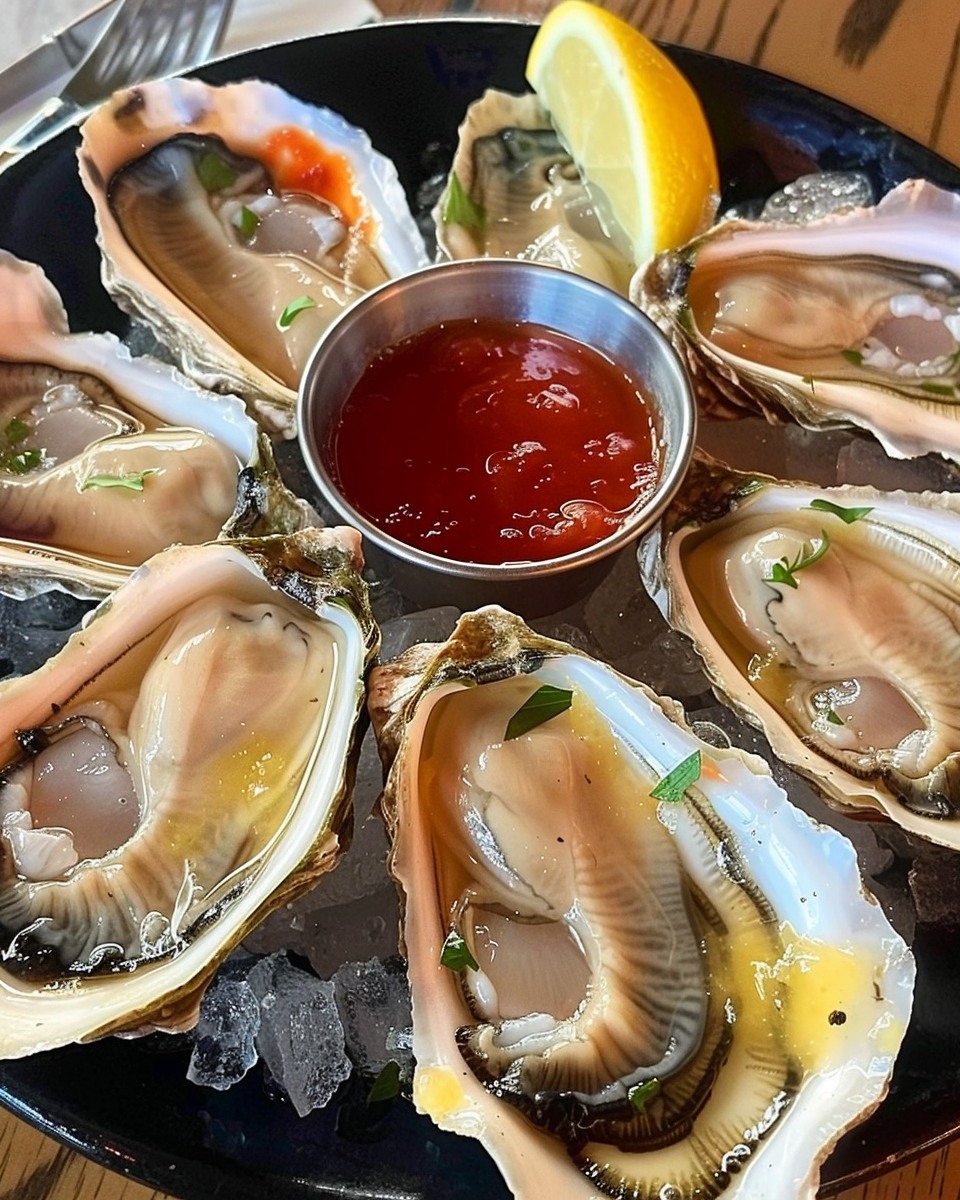Introduction
Overview of the Dish
Oysters have long been revered as a delicacy, particularly in coastal regions where they are freshly harvested from the sea. These bivalves are not only a culinary treasure but also hold cultural significance in many societies. The act of consuming raw oysters is often associated with luxury, celebration, and a connection to the ocean’s bounty.
One of the most popular ways to enjoy oysters is with a simple yet powerful pairing: lemon juice and hot sauce. This combination has become a favorite among oyster enthusiasts due to its ability to enhance the natural flavors of the oysters without overwhelming them.
Why Oysters with Lemon Juice and Hot Sauce?
The appeal of oysters with lemon juice and hot sauce lies in the harmonious blend of flavors. The acidity of the lemon juice cuts through the briny, slightly sweet taste of the oysters, bringing out their freshness. Meanwhile, the hot sauce adds a spicy kick that complements the oyster’s smooth texture. Together, these elements create a balanced and refreshing culinary experience that is both simple and sophisticated.
Ingredients
Selecting the Right Oysters
When it comes to oysters, freshness is key. The most commonly used varieties for this dish include Blue Point, Kumamoto, and Pacific oysters. Each type has its own unique flavor profile—Blue Points are known for their mild, briny taste, Kumamotos are sweet and delicate, and Pacific oysters offer a more robust, mineral flavor.
Tips for Choosing Fresh Oysters
- Appearance: Look for oysters with tightly closed shells. An open shell could indicate that the oyster is dead or not fresh.
- Smell: Fresh oysters should have a clean, ocean-like smell. If they smell fishy or off, they should be avoided.
Lemon Juice
The type of lemon used can significantly affect the flavor. Meyer lemons, for instance, are sweeter and less acidic than regular lemons, making them a great choice for those who prefer a milder citrus flavor.
Fresh-Squeezed vs. Bottled Lemon Juice
- Fresh-Squeezed: Offers a vibrant, tangy flavor that enhances the oyster’s natural taste.
- Bottled: While convenient, bottled lemon juice can lack the freshness and zest of freshly squeezed juice.
Hot Sauce
Hot sauce is the fiery counterpart to the lemon juice in this classic pairing. Popular choices include Tabasco, Crystal, and homemade variations. Each sauce has its own flavor profile—Tabasco is known for its vinegary sharpness, while Crystal is milder and more savory.
Flavor Profiles and Heat Levels
- Mild: Sauces like Crystal offer a subtle heat that doesn’t overpower the oysters.
- Medium: Tabasco provides a moderate kick with a tangy flavor.
- Hot: Homemade sauces or those made with habanero peppers deliver intense heat and complexity.
Optional Additions
While lemon juice and hot sauce are the stars of this dish, other toppings can add depth and variety:
- Mignonette Sauce: A classic French condiment made with vinegar, shallots, and pepper.
- Horseradish: Adds a sharp, pungent flavor that pairs well with oysters.
- Cocktail Sauce: A sweet and tangy option made with ketchup, horseradish, and lemon juice.
- Garnishes: Fresh herbs like parsley or cilantro can add a pop of color and freshness.
Instructions: Step-by-Step
Step 1: Preparing the Oysters
Cleaning and Shucking
Before you can enjoy your oysters, they need to be cleaned and shucked. Here’s how:
- Cleaning: Rinse the oysters under cold water to remove any dirt or debris. Use a brush if necessary.
- Shucking: Hold the oyster in a towel to protect your hand and insert an oyster knife into the hinge of the shell. Twist the knife to pop the shell open, then slide the knife along the top shell to sever the muscle. Remove the top shell and check the oyster for any remaining shell fragments.
Checking for Freshness
- Discard any oysters with cracked shells or a foul odor.
- A good oyster should be plump and slightly translucent.
Step 2: Prepping the Lemon Juice
Maximizing Juice Yield
- Roll the lemon on the countertop with your palm to soften it.
- Cut the lemon in half and use a reamer or juicer to extract as much juice as possible.
Straining the Juice
- Pour the juice through a fine mesh sieve to remove any seeds or pulp, ensuring a smooth application on the oysters.
Step 3: Adding the Hot Sauce
Application Tips
- Start with a few drops of hot sauce on each oyster, then adjust to taste.
- Be mindful of the heat level—it’s easier to add more than to take away.
Balancing Heat Preferences
- Offer a variety of hot sauces so guests can choose their preferred level of spiciness.
Step 4: Serving the Oysters
Plating Ideas
- Arrange the oysters on a bed of crushed ice to keep them cold and fresh.
- Consider adding lemon wedges and small bottles of hot sauce on the side for easy access.
Tips for Keeping Oysters Cold
- Serve immediately after preparation to ensure the oysters remain at their best temperature and texture.
Step 5: Optional Enhancements
Alternative Serving Options
- Add a dollop of mignonette sauce or a squeeze of lime for a different flavor profile.
- Serve with saltine crackers, which are a traditional accompaniment to oysters.
Side Accompaniments
- Light salads or a simple baguette can complement the oysters without overpowering them.
Serving Suggestions
Pairing with Beverages
Wine Pairings
- Crisp White Wines: Sauvignon Blanc, with its citrus notes, pairs perfectly with the lemon juice and hot sauce. Champagne is another excellent choice, offering a celebratory touch with its bubbles and acidity.
Non-Alcoholic Options
- Sparkling Water: A refreshing, neutral choice that allows the oysters’ flavors to shine.
- Iced Tea: A light, slightly sweet option that can balance the heat from the hot sauce.
Complementary Dishes
Sides
- A light cucumber salad can add a refreshing contrast to the richness of the oysters.
- Garlic bread provides a warm, savory element that complements the cool, briny oysters.
Full Meal Creation
- To create a full meal, consider pairing the oysters with grilled seafood, a fresh vegetable platter, or a light pasta dish.
Presentation Tips
Creative Serving Ideas
- For a dinner party, consider creating themed oyster platters featuring regional varieties with different sauces.
- Use oyster shells as individual serving vessels for a rustic, elegant presentation.
Conclusion
Recap of the Recipe
Preparing oysters with lemon juice and hot sauce is a simple yet sophisticated culinary experience. The key steps—selecting fresh oysters, squeezing fresh lemon juice, and adding just the right amount of hot sauce—combine to create a dish that is both refreshing and flavorful.
Encouragement to Experiment
Don’t be afraid to experiment with different hot sauces, citrus options, or even the type of oysters you use. Each variation offers a new way to enjoy this classic dish, allowing you to discover your perfect flavor combination.
FAQs
What Are the Best Oysters for This Recipe?
- Best Varieties: Blue Point, Kumamoto, and Pacific oysters are excellent choices.
- Alternatives: If you prefer a sweeter taste, try Kumamotos; for a stronger, briny flavor, Pacific oysters are ideal.
How Do I Safely Shuck Oysters?
- Safety Tips: Always use a towel to protect your hand and a proper oyster knife for shucking.
- Tools Needed: An oyster knife and a sturdy, clean towel.
Can I Use Bottled Lemon Juice?
- Flavor Comparison: Fresh-squeezed lemon juice provides a more vibrant, natural flavor compared to bottled juice, which may have preservatives.
- Best Practices: If using bottled juice, choose a high-quality brand without added sugar or preservatives.
What Hot Sauce Should I Use?
- Popular Choices: Tabasco for a medium kick, Crystal for mild heat, or homemade sauces for a personalized touch.
- Selecting Heat Levels: Consider your heat tolerance and the oyster’s flavor when choosing a sauce.
How Should I Store Leftover Oysters?
- Storage Tips: Keep oysters on ice in the refrigerator and consume them within a day or two.
- Reviving Dry Oysters: If oysters dry out slightly, they can be soaked briefly in a salted water solution to rehydrate them.

